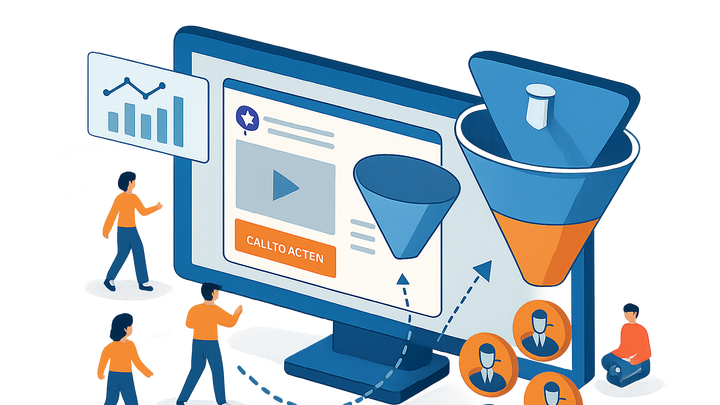Published on 2025-06-29T21:19:37Z
What is B2B Lead Generation? Examples for Prevue.me
B2B lead generation is the strategic process by which businesses attract, capture, and nurture potential clients through their digital channels, particularly websites. In the context of CRO, UX, and SEO, it focuses on optimizing visitor experiences and search visibility to convert prospects into actionable sales leads. This involves deploying targeted lead magnets, crafting intuitive landing pages, and deploying compelling calls-to-action (CTAs) to collect contact information. Effective B2B lead generation aligns marketing and sales efforts, delivering qualified prospects that fuel the sales pipeline and maximize revenue. Continuous data-driven optimization across design, content, and technical SEO underpins successful lead generation campaigns. By continually refining these elements, B2B organizations can scale their marketing efforts and achieve predictable revenue growth.
B2b lead generation
Strategies and best practices for generating B2B leads through optimized websites leveraging CRO, UX, and SEO.
Why B2B Lead Generation Matters
In a B2B context, generating leads is a critical driver of revenue and growth. For websites focusing on CRO, UX, and SEO, B2B lead generation ensures that digital efforts translate into tangible business opportunities. Effective lead generation also provides valuable insights into target customer behavior, informing UX and content strategies. It helps align marketing with sales by delivering qualified prospects into the pipeline. Without a steady stream of leads, B2B websites struggle to sustain growth and justify their digital investments.
-
Revenue growth
Leads are the lifeblood of B2B sales cycles, fueling long-term revenue and maximizing ROI on marketing spend.
-
Sales and marketing alignment
Generating qualified leads fosters closer collaboration between sales and marketing teams, improving conversion efficiency.
-
Data-driven optimization
Lead generation forms and interactions produce data that guide CRO, UX, and SEO improvements.
Core Components of B2B Lead Generation Strategies
B2B websites employ a range of tactics to capture and nurture leads. From gated content to interactive tools, each component plays a unique role in attracting and converting potential customers. Combining these elements effectively creates a seamless journey from first contact to qualified lead. This section explores the foundational elements of successful B2B lead generation.
-
Lead magnets
High-value resources like whitepapers, eBooks, and webinars offered in exchange for contact information.
- Content relevance:
Ensure your lead magnet addresses specific pain points of your target audience.
- Design and ux:
A visually appealing layout and easy download process improve conversions.
- Content relevance:
-
Landing pages
Dedicated pages optimized for capturing visitor information through focused messaging and forms.
- Clear headline:
A concise, benefit-driven headline that communicates value instantly.
- Minimal distractions:
Limit navigation and links to keep visitors focused on the conversion goal.
- Clear headline:
-
Calls to action (ctas)
Buttons or links prompting users to take a specific action, like ‘Download Now’ or ‘Request a Demo.’
- Cta placement:
Position CTAs where they are easily visible without overwhelming the page.
- Action-oriented copy:
Use verbs and urgency to encourage clicks.
- Cta placement:
Optimizing B2B Lead Generation with CRO, UX, and SEO
Integrating CRO, UX, and SEO best practices into your B2B lead generation strategy ensures your website attracts qualified traffic and converts efficiently. Each discipline complements the others by improving visibility, engagement, and conversion rates. In this section, we’ll look at how to optimize each facet for maximum lead generation impact.
-
Conversion rate optimization (cro)
Systematic testing of page elements—headlines, forms, layouts—to maximize the percentage of visitors who convert to leads.
- A/b testing:
Run experiments on page variants to identify the highest-performing versions.
- Form optimization:
Reduce fields and use smart forms to decrease friction and abandonment.
- A/b testing:
-
User experience (ux)
Designing intuitive, user-friendly interfaces that guide visitors toward conversion goals.
- Information architecture:
Organize content hierarchically to help users find what they need quickly.
- Responsive design:
Ensure forms, CTAs, and content are accessible and user-friendly across devices.
- Information architecture:
-
Search engine optimization (seo)
Optimizing on-page and technical SEO factors to attract relevant organic traffic that is more likely to convert.
- Keyword targeting:
Research and integrate high-intent keywords into landing page copy and meta data.
- Page speed:
Improve load times to reduce bounce rates and support search rankings.
- Keyword targeting:
Leveraging Prevue.me for Actionable Website Critiques
prevue.me provides targeted critiques across CRO, lead generation, SEO, UX, and accessibility. By leveraging its insights, B2B marketers can quickly identify areas of improvement, prioritize fixes, and implement changes that drive higher lead volumes. This section demonstrates how to use prevue.me features to fine-tune your lead gen strategy.
-
Cro feedback
prevue.me analyzes page layouts, CTAs, and forms to deliver personalized CRO recommendations.
-
Lead generation insights
Identify drop-off points in your funnel and receive suggestions for optimizing lead magnets and landing pages.
-
Seo audits
Automated audit of on-page SEO elements, including keywords, metadata, and content structure.
-
Ux & accessibility recommendations
Actionable guidance to improve navigation, readability, and compliance with accessibility standards.
Measuring and Iterating Lead Generation Performance
Continuous measurement and iteration are vital for refining your B2B lead generation process. By tracking key metrics and conducting regular audits, you can identify bottlenecks, test improvements, and scale what works. This section outlines best practices for monitoring performance and making data-driven decisions.
-
Key metrics to track
Monitor metrics like conversion rate, cost per lead (CPL), Marketing Qualified Leads (MQLs), and Sales Qualified Leads (SQLs).
-
Feedback loops
Establish processes for sales teams to provide feedback on lead quality and follow-up outcomes.
-
Continuous testing
Maintain a culture of experimentation with regular A/B tests, design tweaks, and SEO updates.
